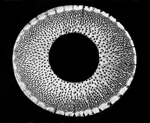|
1621-1625: Neo-Confucian Scholar Hayashi Razan's Writings
on 'Shakuhachi', 'Komosō', and Related Matters
1621:
暮露暮露 - BOROBORO
薦僧 - KOMOSŌ
徒然草野槌 - TSUREZUREGUSA NOZUCHI by HAYASHI RAZAN
" - - - According to the 'Boro-boro Story Book', the empty sky priests were 7 feet 8 inches tall and tough and strong.
Clad in paper garments decorated with designs, they carried swords which were 1 foot 8 inches long, and held octagonal, rattan-wound shafts by their sides.
Walking on high clogs 1 foot 5 inches tall, their hair long and black, they came to be known as 'Boro'.
It is being said that they took beautiful wives as spouses and travelled together all over the country in groups of thirty."
其後に薦僧と云もの僧とも見えず俗とも見えず山伏ともみえず,
刀をさし尺八を吹せなかにむしろをおひ道路をありき人の門戸に立て物を乞もらふ.
是ぼろ々々の流也, と云傳へたり。
"Later, as for the 'Komosō', they appear to have been neither monks, laymen, nor 'yamabushi'.
They wore swords and blew the shakuhachi.
Carrying straw mats on their backs they wandered the roads and, they begged for and received alms at people's gates.
This, I am told, is the tradition of the 'Boroboro'. - - - "
Hayashi Razan, 1583-1657, in 'Tsurezuregusa nozuchi', "Excursions
into the Tsurezuregusa". Written in 1621. Published in 1648.
Printed in 1667. Trsl. by Torsten Olafsson, 1986-87.
Source: Kurihara Kōta, 1918.

Hayashi Razan (a.k.a. Hayashi Dōshun) - artist and date unknown
尺八記
1623 - SHAKUHACHI (no) KI by HAYASHI RAZAN
吾國近代有宇治庵主狂雲子一路叟者並避世之徒也。
倶吹尺八。
" - - - In our country, in recent times, there were [two] persons who lived as hermits in
Uji, Kyōun [pseudonym for Ikkyū Sōjun,
一休宗純, [1394-1481] and Ichirōsō, who had abandoned the world.
They [both] played the shakuhachi [together]. - - - "
Hayashi Razan, 1583-1657, in 'Shakuhachi (no) ki',
"Shakuhachi Chronicle". Dated Genna 9, 1623.
Trsl. by Torsten Olafsson, 2013. In vol. 19 of:
Hayashi Razan bunshū, "Collected Writings by
Hayashi Razan", Kōbunsha, Kyōto, 1930, pp. 217.
Link to online version:
Hayashi Razan bunshū
餘音尺八記
1625 - YOIN SHAKUHACHI (no) KI by HAYASHI RAZAN




Hayashi Razan's 'Yoin shakuhachi (no) ki
Hayashi Razan, 1583-1657, in 'Yoin shakuhachi (no) ki',
"Further Notes to the Shakuhachi Chronicle". Dated Genna 11, 1625.
In vol. 19 of:
Hayashi Razan bunshū, "Collected Writings by
Hayashi Razan", Kōbunsha, Kyōto, 1930, pp. 218.
Link to online version:
Hayashi Razan bunshū
See also: Linder, 2012, p. 213.
|
|





